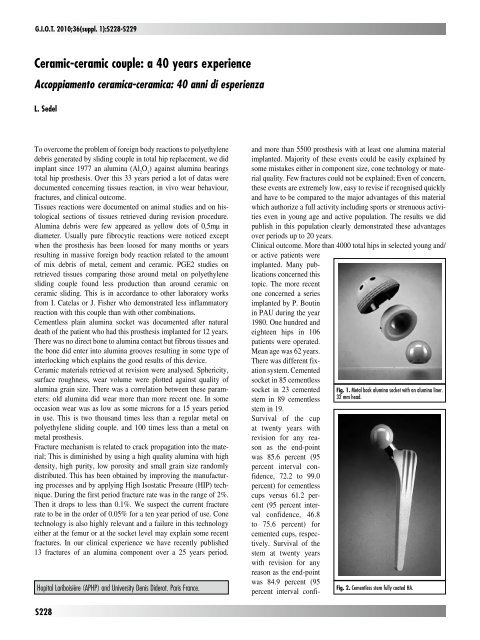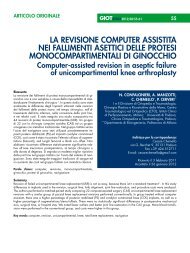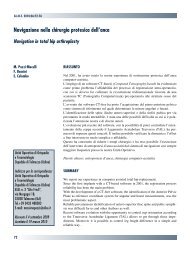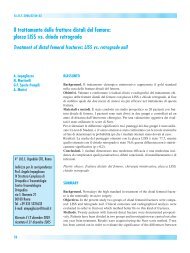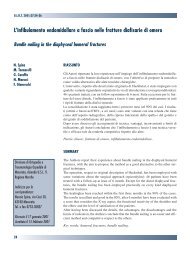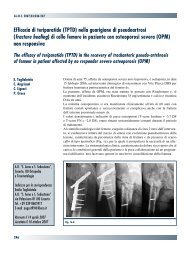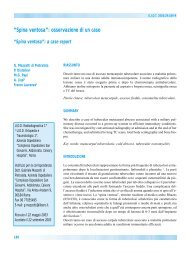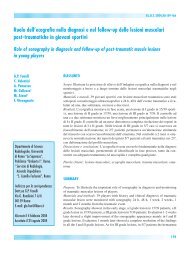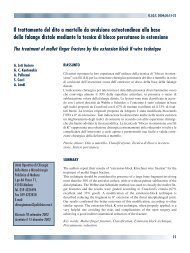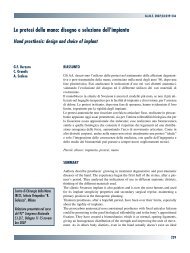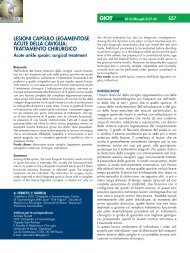30845 Suppl Giot.pdf - Giornale Italiano di Ortopedia e Traumatologia
30845 Suppl Giot.pdf - Giornale Italiano di Ortopedia e Traumatologia
30845 Suppl Giot.pdf - Giornale Italiano di Ortopedia e Traumatologia
Create successful ePaper yourself
Turn your PDF publications into a flip-book with our unique Google optimized e-Paper software.
G.I.O.T. 2010;36(suppl. 1):S228-S229<br />
Ceramic-ceramic couple: a 40 years experience<br />
Accoppiamento ceramica-ceramica: 40 anni <strong>di</strong> esperienza<br />
L. Sedel<br />
To overcome the problem of foreign body reactions to polyethylene<br />
debris generated by sli<strong>di</strong>ng couple in total hip replacement, we <strong>di</strong>d<br />
implant since 1977 an alumina (Al 2 O 3 ) against alumina bearings<br />
total hip prosthesis. Over this 33 years period a lot of datas were<br />
documented concerning tissues reaction, in vivo wear behaviour,<br />
fractures, and clinical outcome.<br />
Tissues reactions were documented on animal stu<strong>di</strong>es and on histological<br />
sections of tissues retrieved during revision procedure.<br />
Alumina debris were few appeared as yellow dots of 0,5mμ in<br />
<strong>di</strong>ameter. Usually pure fibrocytic reactions were noticed except<br />
when the prosthesis has been loosed for many months or years<br />
resulting in massive foreign body reaction related to the amount<br />
of mix debris of metal, cement and ceramic. PGE2 stu<strong>di</strong>es on<br />
retrieved tissues comparing those around metal on polyethylene<br />
sli<strong>di</strong>ng couple found less production than around ceramic on<br />
ceramic sli<strong>di</strong>ng. This is in accordance to other laboratory works<br />
from I. Catelas or J. Fisher who demonstrated less inflammatory<br />
reaction with this couple than with other combinations.<br />
Cementless plain alumina socket was documented after natural<br />
death of the patient who had this prosthesis implanted for 12 years.<br />
There was no <strong>di</strong>rect bone to alumina contact but fibrous tissues and<br />
the bone <strong>di</strong>d enter into alumina grooves resulting in some type of<br />
interlocking which explains the good results of this device.<br />
Ceramic materials retrieved at revision were analysed. Sphericity,<br />
surface roughness, wear volume were plotted against quality of<br />
alumina grain size. There was a correlation between these parameters:<br />
old alumina <strong>di</strong>d wear more than more recent one. In some<br />
occasion wear was as low as some microns for a 15 years period<br />
in use. This is two thousand times less than a regular metal on<br />
polyethylene sli<strong>di</strong>ng couple. and 100 times less than a metal on<br />
metal prosthesis.<br />
Fracture mechanism is related to crack propagation into the material;<br />
This is <strong>di</strong>minished by using a high quality alumina with high<br />
density, high purity, low porosity and small grain size randomly<br />
<strong>di</strong>stributed. This has been obtained by improving the manufacturing<br />
processes and by applying High Isostatic Pressure (HIP) technique.<br />
During the first period fracture rate was in the range of 2%.<br />
Then it drops to less than 0.1%. We suspect the current fracture<br />
rate to be in the order of 0.05% for a ten year period of use. Cone<br />
technology is also highly relevant and a failure in this technology<br />
either at the femur or at the socket level may explain some recent<br />
fractures. In our clinical experience we have recently published<br />
13 fractures of an alumina component over a 25 years period.<br />
Hopital Lariboisière (APHP) and University Denis Diderot. Paris France.<br />
S228<br />
and more than 5500 prosthesis with at least one alumina material<br />
implanted. Majority of these events could be easily explained by<br />
some mistakes either in component size, cone technology or material<br />
quality. Few fractures could not be explained; Even of concern,<br />
these events are extremely low, easy to revise if recognised quickly<br />
and have to be compared to the major advantages of this material<br />
which authorize a full activity inclu<strong>di</strong>ng sports or strenuous activities<br />
even in young age and active population. The results we <strong>di</strong>d<br />
publish in this population clearly demonstrated these advantages<br />
over periods up to 20 years.<br />
Clinical outcome. More than 4000 total hips in selected young and/<br />
or active patients were<br />
implanted. Many publications<br />
concerned this<br />
topic. The more recent<br />
one concerned a series<br />
implanted by P. Boutin<br />
in PAU during the year<br />
1980. One hundred and<br />
eighteen hips in 106<br />
patients were operated.<br />
Mean age was 62 years.<br />
There was <strong>di</strong>fferent fixation<br />
system. Cemented<br />
socket in 85 cementless<br />
socket in 23 cemented<br />
stem in 89 cementless<br />
stem in 19.<br />
Survival of the cup<br />
at twenty years with<br />
revision for any reason<br />
as the end-point<br />
was 85.6 percent (95<br />
percent interval confidence,<br />
72.2 to 99.0<br />
percent) for cementless<br />
cups versus 61.2 percent<br />
(95 percent interval<br />
confidence, 46.8<br />
to 75.6 percent) for<br />
cemented cups, respectively.<br />
Survival of the<br />
stem at twenty years<br />
with revision for any<br />
reason as the end-point<br />
was 84.9 percent (95<br />
percent interval confi-<br />
Fig. 1. Metal back alumina socket with an alumina liner.<br />
32 mm head.<br />
Fig. 2. Cementless stem fully coated HA.


